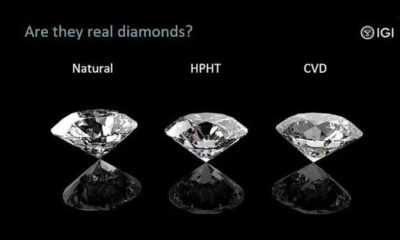JB Insights
Unleashing creativity: the design freedom offered by lab-grown diamonds
By Lisa Mukhedkar-Founder and CEO Aukera- Lab Grown Diamond Jewellery


Lisa Mukhedkar is the Founder of Aukera- Lab Grown Diamond Jeweller
Lab-grown diamonds are emerging as a compelling alternative to traditionally mined stones in the dynamic world of fine jewellery. As dazzling as their natural counterparts in brilliance, durability, and composition, these lab-made marvels are not just rewriting the rules of luxury but also redefining what it means to wear jewellery, with conscience and creativity.
What truly sets lab-grown diamonds apart, however, is the extraordinary design freedom they offer. With greater availability and more accessible price points—nearly 30-40% lower than mined diamonds—designers and consumers alike are no longer restricted by cost when it comes to scale, setting, or innovation. Larger, high-quality stones can be incorporated into custom designs, allowing bold artistic visions to flourish without compromise.
India’s lab-grown diamond jewellery market, pegged at $264.5 million in 2022, will grow at 14.8% CAGR, reaching $1,192.3 million by 2033, as per an ET Retail report. This explains the shift in consumer mindset, particularly evident among younger buyers, who are seeking jewellery that reflects their values and personal stories. Engagement rings, in particular, have become deeply personal artefacts—designed not just to symbolise love but to express individuality. Many couples are veering away from the conventional solitaire and opting for coloured stones, unique cuts, asymmetry, and mixed metal bands. From astrological motifs and birthstones to rings that incorporate the story of a couple’s journey, the emphasis is on crafting a ring that speaks of individuality.
Designers are responding to this demand with greater creative freedom, made possible by the versatility and easy availability of lab-grown diamonds. These diamonds enable quick customisation with technical precision, allowing customers to bring their unique visions to life, without the steep price tag or ethical ambiguity of mined stones.
This creative liberation is fuelling a wave of experimentation in contemporary jewellery design. There’s a noticeable move toward mixing metals—pairing white and yellow gold or combining rose gold with platinum—to create unique, expressive pieces. Asymmetrical settings, bold colour contrasts, and unorthodox stone placements are also on the rise, making each piece a true reflection of the wearer’s personality.
Even men’s jewellery is seeing a shift, with lab-grown diamonds being used in refined, minimalist styles like cufflinks, bands, and bracelets. These modern pieces reflect not just personal style but also an alignment with sustainable and ethical values—key concerns for today’s consumer.
With a far lower price tag but the same clarity, brilliance, and sparkle, lab-grown diamonds stand out for their sheer versatility. You no longer have to burn a hole in your finances to own jewellery that’s both trendy and just as dazzling as mined diamonds.
Moreover, lab-grown diamonds are ushering in a more democratic era of bespoke design. Thanks to advances in production and design technology, custom creations can now be brought to life rapidly and with exacting detail. This opens doors for more people to own jewellery that is not only beautiful but also meaningful and responsibly sourced.
Ultimately, lab-grown diamonds are not just about sustainability or savings—they are about creative freedom. As the boundaries of jewellery design expand, these stones enable consumers and designers to dream bigger, bolder, and express more freely.

JB Insights
JMA Forum Seminar on MSME Schemes & Capital Raising
Experts discussed growth opportunities, innovations, challenges in MSME sector

The Jewellery Machinery and Allied Association – JMA Forum successfully organized its MSME Seminar- MSME Schemes & Capital Raising– specially designed for jewellery machine manufacturers to gain insights, explore opportunities, and grow business. It brought together industry leaders, entrepreneurs, and experts to discuss growth opportunities, innovations, and challenges in the MSME sector.

The event saw an enthusiastic response from about 120 participants, with insightful sessions covering finance, technology adoption, market expansion, and policy support for MSMEs. Eminent speakers shared practical strategies to empower small and medium enterprises, ensuring sustainable and competitive growth.
Present were members of the jewellery machine manufacturers fraternity, industry leaders, Naresh Balani, Chairman-JMA and Kranti Nagvekar, founder -KNC Services. JMA thanked all attendees, speakers, and partners for making this seminar a grand success sand reaffirming its commitment to the progress of the JMA community.
-

 National News2 weeks ago
National News2 weeks agoGST on gold, silver jewellery remains unchanged at 3%, with additional 5% on making charges
-

 ShowBuzz35 minutes ago
ShowBuzz35 minutes agoShri Devendra Fadnavis unveils GJS – The Diwali Edition 2025 at JWCC, Mumbai
-

 New Premises53 minutes ago
New Premises53 minutes agoVasundhra Raj unveils showroom at Noida
-

 DiamondBuzz3 hours ago
DiamondBuzz3 hours agoAll non-natural diamonds to be labelled only as “synthetic: CIBJO




